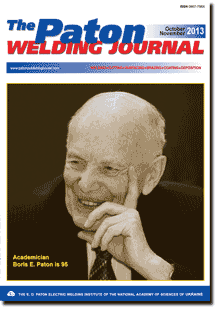| 2013 №11 (04) | 2013 №11 (06) |

The Paton Welding Journal, 2013, #10/11, 44-48 pages
RECENT ADVANCES IN THE QUANTITATIVE UNDERSTANDING OF FRICTION STIR WELDING
A. DE1 and T. DEBROY2
1Indian Institute of Technology, Bombay, India2The PennsylvaniaStateUniversity, University Park, PA, USA. E-mail: amit@iitb.ac.in
Abstract
Friction stir welding (FSW) is a relatively new welding process and its comprehensive understanding is still developing. While the process is commercially used for aluminum and other soft alloys, its commercial application for the welding of hard alloys will require development of cost-effective and durable tools. Here we review the recent progress made in numerical modeling heat transfer and material flow with particular emphasis on optimizing tool dimensions and selection of welding conditions for maximizing tool durability. 22 Ref., 2 Tables, 6 Figures.
Keywords: friction stir welding, numerical modeling, heat transfer, material flow, welding conditions, tool durability
Received: 21.06.13
Published: 06.11.13
References
1. Mishra, R.S., Ma, Z.Y. (2005) Friction stir welding and processing. Mater. Sci. Eng. R, 50(1/2), 1-78.
2. Nandan, R., DebRoy, T., Bhadeshia, H.K.D.H. (2008) Recent advances in friction-stir welding Е process, weldment structure and properties. Prog. Mater. Sci., 53(6), 980-1023.
3. Threadgill, P.L., Leonard, A.J., Shercliff, H.R. et al. (2009) Friction stir welding of aluminum alloys. Int. Mater. Rev., 54(2), 49-93.
4. Bhadeshia, H.K.D.H., DebRoy, T. (2009) Critical assessment: friction stir welding of steels. Sci. Technol. Weld. Joining, 14(3), 193-196.
5. DebRoy, T., Bhadeshia, H.K.D.H. (2010) Friction stir welding of dissimilar alloys Е a perspective. Ibid., 15(4), 266-270.
6. Heideman, R., Johnson, C., Kou, S. (2010) Metallurgical analysis of Al/Cu friction stir spot welding. Ibid., 15(7), 597-604.
7. Nandan, R., Roy, G.G., DebRoy, T. (2006) Numerical simulation of three-dimensional heat transfer and plastic flow during friction stir welding. Metallurgical and Materials Transact. A, 37A, 1247-1259.
8. Nandan, R., Roy, G.G., Lienert, T.J. et al. (2007) Three-dimensional heat and material flow during friction stir welding of mild steel. Acta Materialia, 55, 883-895.
9. Colegrove, P.A., Shercliff, H.R., Zettler, R. (2007) A model for predicting the heat generation and temperature in friction stir welding from the material properties. Sci. Technol. Weld. Joining, 12(4), 284-297.
10. Nandan, R., Lienert, T.J., DebRoy, T. (2008) Toward reliable calculations of heat and plastic flow during friction stir welding of Ti-6Al-4V alloy. Int. J. of Materials Research, 99(4), 434-444.
11. Arora, A., Nandan, R., Reynolds, A.P. et al. (2009) Torque, power requirement and stir zone geometry in friction stir welding through modeling and experiments. Scr. Mater., 60, 13-16.
12. Arora, A., Zhang, Z., De, A. et al. (2009) Strain and strain rates during friction stir welding. Ibid., 61, 863-866.
13. Arora, A., DebRoy, T., Bhadeshia, H.K.D.H. (2011) Back of the envelope calculations in friction stir welding Е velocities, peak temperature, torque, and hardness. Acta Mater., 59(5), 2020-2028.
14. Mehta, M., Arora, A., De, A. et al. (2011) Tool geometry for friction stir welding Е optimum shoulder diameter. Metall. Mater. Transact. A, 42A(9), 2716-2722.
15. Arora, A., De, A., DebRoy, T. (2011) Toward optimum friction stir welding tool shoulder diameter. Scripta Mater., 64(1), 9-12.
16. Elangovan, K., Balasubramanian, V. (2008) Influences of tool pin profile and tool shoulder diameter on the formation of friction stir processing zone in AA6061 aluminium alloy. Mater. Des., 29(2), 362-373.
17. Rai, R., De, A., Bhadeshia, H.K.D.H. et al. (2011) Review: friction stir welding tools. Sci. Technol. Weld. Joining, 16(4), 325-342.
18. Mehta, M., Arora, A., De, A. et al. (2012) Load bearing capacity of tool pin during friction stir welding. Int. J. Adv. Manuf. Technol., 61, 911-920.
19. Mehta, M., De, A., DebRoy, T. (2013) Probing load bearing capacity of circular and non-circular tool pins in friction stir welding. In: Proc. of 9th Int. Conf. on «Trends in Welding Research» (Chicago, USA, June 04-08, 2012), ASM International, 563-571.
20. Sorensen, C.D., Stahl, A.L. (2007) Experimental measurement of load distribution on friction stir weld pin tools. Metall. Mater. Transact. B, 38B, 451-459.
21. Manvatkar, V.D., Arora, A., De, A. et al. (2012) Neural network models for peak temperature, torque, traverse force, bending stress and maximum shear stress during friction stir welding. Sci. Technol. Weld. Joining, 17(6), 460-466.
22. DebRoy, T., De, A., Bhadeshia, H.K.D.H. et al. (2012) Tool durability maps for friction stir welding of an aluminum alloy. Proc. of the Royal Society A, 468, 3552-3570.
Suggested Citation
A. DE and T. DEBROY (2013) RECENT ADVANCES IN THE QUANTITATIVE UNDERSTANDING OF FRICTION STIR WELDING. The Paton Welding J., 11, 44-48.The cost of subscription/purchase order journals or individual articles
| Journal/Currency | Annual Set | 1 issue printed |
1 issue |
one article |
| TPWJ/USD | 384 $ | 32 $ | 26 $ | 13 $ |
| TPWJ/EUR | 348 € | 29 € | 24 € | 12 € |
| TPWJ/UAH | 7200 UAH | 600 UAH | 600 UAH | 280 UAH |
| AS/UAH | 1800 UAH | 300 UAH | 300 UAH | 150 UAH |
| AS/USD | 192 $ | 32 $ | 26 $ | 13 $ |
| AS/EUR | 180 € | 30 € | 25 € | 12 € |
| SEM/UAH | 1200 UAH | 300 UAH | 300 UAH | 150 UAH |
| SEM/USD | 128 $ | 32 $ | 26 $ | 13 $ |
| SEM/EUR | 120 € | 30 € | 25 € | 12 € |
| TDNK/UAH | 1200 UAH | 300 UAH | 300 UAH | 150 UAH |
| TDNK/USD | 128 $ | 32 $ | 26 $ | 13 $ |
| TDNK/EUR | 120 € | 30 € | 25 € | 15 € |
AS = «Automatic Welding» - 6 issues per year;
TPWJ = «PATON WELDING JOURNAL» - 12 issues per year;
SEM = «Electrometallurgy Today» - 4 issues per year;
TDNK = «Technical Diagnostics and Non-Destructive Testing» - 4 issues per year.


